- How to Prune Currants
- 1. Choose the right time to prune
- 2. Remove any damaged or diseased branches
- 3. Thin out the oldest branches
- 4. Cut back the remaining branches
- 5. Prune suckers and low-lying branches
- 6. Clean up and dispose of pruning debris
- 7. Consider annual pruning maintenance
- Tips for Pruning Black Currant Plants
- Advice for Pruning Red Currant Plants
- 1. Timing
- 2. Remove Old Wood
- 3. Thin Out Branches
- 4. Prune for Shape
- 5. Prune for Size Control
- 6. Remove Suckers
- 7. Consider Fruit Production
- 8. Sanitize Tools
- Proper Pruning for White Currant Plants
- When to Prune White Currant Plants
- Tools Needed for Pruning
- Steps for Pruning White Currant Plants
- Tips for Pruning White Currant Plants
- When is the Best Time to Prune Currant Plants?
- Benefits of pruning currant plants in late winter or early spring:
- Steps to prune currant plants:
- Important tips for pruning currant plants:
- Tools and Equipment Needed for Pruning Currant Plants
- Step-by-Step Guide to Pruning Currant Plants
- 1. Choose the Right Time to Prune
- 2. Gather the Necessary Tools
- 3. Remove Dead or Diseased Wood
- 4. Thin Out the Branches
- 5. Prune for Shape and Size
- 6. Consider the Type of Currant Plant
- 7. Clean Up and Dispose of Pruned Material
- 8. Mulch and Fertilize
- 9. Monitor Growth and Prune Annually
- Common Mistakes to Avoid When Pruning Currant Plants
- Tips for Maintaining Healthy Currant Plants After Pruning
- 1. Mulch around the base of the plants
- 2. Water regularly
- 3. Fertilize appropriately
- 4. Monitor for pests and diseases
- 5. Support the branches
- 6. Maintain good air circulation
- 7. Harvest the fruits promptly
- Question-answer:
- When is the best time to prune currants?
- How much should I prune off my currant plants?
- Should I prune the new growth on my currant plants?
- Can I prune my currant plants during the summer?
- What are the benefits of pruning currant plants?
- Video: How to prune a red or white currant bush
Pruning currant plants is an essential part of maintaining their health and productivity. Whether you have black, red, or white currant plants, proper pruning techniques can help enhance their overall growth, fruit production, and shape. In this article, we will provide you with tips on how to prune currants effectively.
Why prune currant plants?
Pruning currant plants is necessary to remove damaged or dead wood, improve airflow and light penetration, and promote new growth. Removing these unwanted branches not only enhances the plant’s appearance but also prevents the spread of diseases and pests. Pruning also helps to maintain the size and shape of the plant, making it easier to harvest the fruits.
When to prune currant plants?
The best time to prune currant plants is during late winter or early spring, while the plants are still dormant. Pruning during this time allows the plants to heal quickly and develop new growth before the growing season begins. It is important to prune before the buds start swelling, but after the worst of the winter weather has passed.
How to prune currant plants?
Start by removing any dead, diseased, or broken branches closest to the ground. These branches can hinder airflow and harbor pests and diseases. Next, identify any older, unproductive wood and prune it back to a strong, healthy bud or branch. Thin out any overcrowded areas to promote better airflow and light penetration.
Tip: When pruning, aim to create an open center or vase shape for the currant plant. This shape allows air to circulate freely and ensures that sunlight reaches all parts of the plant.
How to Prune Currants
1. Choose the right time to prune
Pruning currant plants should be done during the dormant season, typically in late winter or early spring before new growth begins. This allows the plants to recover from pruning and promotes healthy, vigorous growth.
2. Remove any damaged or diseased branches
Start by removing any branches that are broken, diseased, or dead. This helps prevent the spread of disease and allows the plant to allocate its resources to healthy branches.
3. Thin out the oldest branches
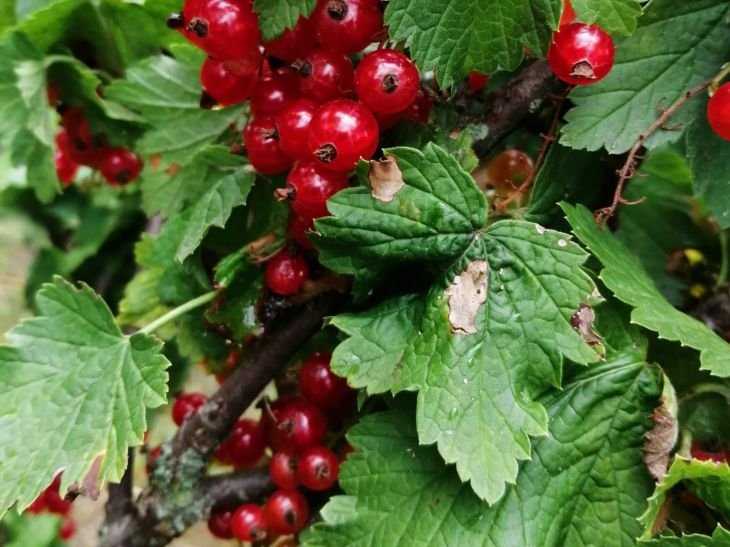
Currant plants produce new growth from the base of the plant each year. To encourage strong growth and maintain a productive plant, remove some of the oldest branches that are no longer productive. This will stimulate the growth of new branches.
4. Cut back the remaining branches
Next, cut back the remaining branches to a desired length. This will help maintain a compact and manageable shape for your currant plant. It’s generally recommended to prune back about one-third of the plant’s branches each year.
5. Prune suckers and low-lying branches
If your currant plant has any suckers or low-lying branches that are crowding the center of the plant, remove them. This will improve air circulation and sunlight penetration, reducing the risk of disease and promoting better fruit production.
6. Clean up and dispose of pruning debris

After pruning, be sure to clean up and remove any pruning debris from the area. This helps prevent the spread of disease and keeps your garden neat and tidy.
7. Consider annual pruning maintenance
Pruning currant plants is an ongoing process. It’s important to prune them every year to ensure healthy growth and fruit production. Regular pruning will also help keep the plant’s shape and size in check.
By following these pruning tips, you can promote the health and productivity of your currant plants and enjoy a bountiful harvest of delicious berries.
Tips for Pruning Black Currant Plants
Pruning black currant plants is an important task to ensure their health and productivity. Here are some tips to help you successfully prune your black currant plants:
- Timing: It is best to prune black currant plants during their dormant period, which is usually in late winter or early spring before new growth begins.
- Tools: Use clean and sharp pruning shears or loppers to make precise cuts without damaging the plant.
- Remove dead and diseased wood: Start by removing any dead or diseased wood. This will help prevent the spread of diseases and stimulate new healthy growth.
- Thin out crowded branches: Remove any branches that are growing too closely together or crossing over each other. This will improve air circulation and sunlight penetration, reducing the risk of fungal diseases.
- Prune to shape: Black currant plants can develop a dense, bushy growth habit. Prune the plant to maintain an open and balanced shape, allowing light to reach all parts of the plant.
- Prune for size control: If the black currant plant is becoming too large for its space, you can prune it back to manage its size. However, be cautious not to remove too much of the plant, as this can reduce fruit production.
- Remove old wood: Black currant plants produce fruit on one-year-old wood. To encourage new growth and fruiting, remove some of the older wood each year.
Remember to clean your pruning tools between cuts to prevent the spread of diseases. After pruning, give your black currant plants a good watering and apply a layer of mulch around the base to help retain moisture and protect the roots.
Advice for Pruning Red Currant Plants
Pruning red currant plants is an essential task to promote healthy growth, maintain a desired shape, and encourage high fruit production. Here are some tips and guidelines for pruning red currant plants:
1. Timing
The best time to prune red currant plants is during late winter or early spring while the plant is still dormant. This allows the plant to recover quickly and produce new growth in the upcoming season.
2. Remove Old Wood
Start by removing any dead, damaged, or diseased wood. This helps prevent the spread of diseases and ensures that the plant allocates its resources to healthy growth.
3. Thin Out Branches
Thin out the branches of the red currant plant to improve air circulation and sunlight penetration. This helps prevent disease and aids in the ripening of the fruit.
4. Prune for Shape
Prune to maintain a well-balanced shape and open center structure. This allows for better light penetration and air circulation, keeping the plant healthy and productive.
5. Prune for Size Control
If your red currant plant has grown too large for its space, you can prune it to manage its size. Remove excessive growth and reshape the plant to maintain a compact form.
6. Remove Suckers
Red currant plants often produce suckers (shoots emerging from the base of the plant) that may drain energy from the main plant. Regularly remove these suckers to maintain the plant’s vigor and prevent overcrowding.
7. Consider Fruit Production
If your primary goal is fruit production, focus on pruning to increase yields. Remove older wood and thin out branches to promote new growth and a higher fruit set.
8. Sanitize Tools
Before and after pruning, sanitize your pruning tools with rubbing alcohol or a bleach solution to prevent the spread of diseases between plants.
Following these pruning tips for red currant plants will help promote their health, productivity, and overall appearance. Remember to regularly assess your currant plants’ growth and adjust your pruning techniques accordingly.
Proper Pruning for White Currant Plants
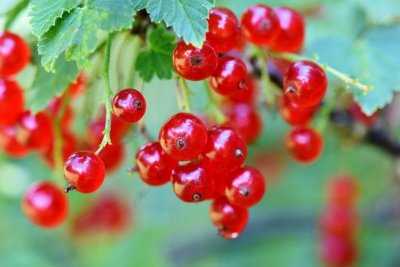
Pruning is an essential task for maintaining the health and productivity of white currant plants. By pruning your white currant plants correctly, you can promote better airflow, reduce disease pressure, and ensure a more bountiful harvest.
When to Prune White Currant Plants
The best time to prune white currant plants is during late winter or early spring, before new growth begins. Pruning during this time allows the plant to focus its energy on new growth and fruit production.
Tools Needed for Pruning
Before you start pruning your white currant plants, gather the necessary tools. These may include:
- Pruning shears
- Loppers (for thicker branches)
- Gloves (to protect your hands)
- Disinfectant spray or rubbing alcohol (to sterilize the tools between cuts)
Steps for Pruning White Currant Plants
Follow these steps to properly prune your white currant plants:
- Begin by removing any dead, damaged, or diseased branches. These branches can hinder the overall health and productivity of the plant.
- Next, remove any crossing branches or those that are growing towards the center of the plant. This will improve airflow and reduce the risk of diseases.
- Thin out the interior of the plant by selectively removing some of the older branches. Aim to maintain an open, vase-like structure that allows sunlight to reach all parts of the plant.
- Shorten the remaining branches by cutting them back to an outward-facing bud or side branch. This will encourage new growth and help maintain a compact shape.
- Remove any suckers or shoots growing from the base of the plant.
Tips for Pruning White Currant Plants
Here are some additional tips to keep in mind while pruning white currant plants:
- Regularly sanitize your pruning tools between cuts to prevent the spread of diseases.
- Avoid pruning white currant plants too heavily, as this can lead to reduced fruit production.
- Young white currant plants may require less pruning compared to older, more established plants.
- Prune white currant plants every year to maintain their shape and productivity.
- After pruning, consider applying a layer of mulch around the base of the plant to help retain moisture and suppress weeds.
By following these pruning techniques, you can help your white currant plants thrive and enjoy a fruitful harvest. Remember, pruning is a skill that improves with practice, so don’t be afraid to experiment and learn what works best for your specific plants.
When is the Best Time to Prune Currant Plants?
Pruning currant plants is an essential task that helps to maintain their health and productivity. Knowing the right time to prune your currant plants is key to ensuring their success. The best time to prune currant plants is in late winter or early spring while the plants are still dormant.
Benefits of pruning currant plants in late winter or early spring:
- Promotes new growth: Pruning during the dormant season stimulates the growth of new shoots and branches.
- Improves airflow: Removing old, diseased, or overcrowded branches allows for better air circulation within the plant, reducing the risk of fungal diseases.
- Enhances fruit production: Pruning encourages currant plants to produce more fruit by directing the plant’s energy towards fruiting branches.
Steps to prune currant plants:
To properly prune your currant plants, follow these steps:
- Remove dead or damaged wood: Start by cutting back any dead or damaged wood to promote new growth.
- Thin out the plant: Remove any crowded or crossing branches to open up the plant and improve airflow.
- Prune for shape: Aim for an open, vase-like shape by cutting back taller branches to encourage growth from lower areas of the plant.
Important tips for pruning currant plants:
- Sanitize your pruning tools: Before pruning, it’s crucial to sanitize your pruning tools with a solution of one part bleach to nine parts water to minimize the risk of spreading diseases.
- Remove the oldest wood: To maintain the vigor of your currant plants, remove the oldest wood every few years to make room for new growth.
- Avoid pruning when buds have started to swell: Pruning too late in spring may remove flower buds and reduce fruit production.
By pruning your currant plants in late winter or early spring, you can promote healthy growth, improve fruit production, and ensure the overall health and vitality of your plants.
Tools and Equipment Needed for Pruning Currant Plants
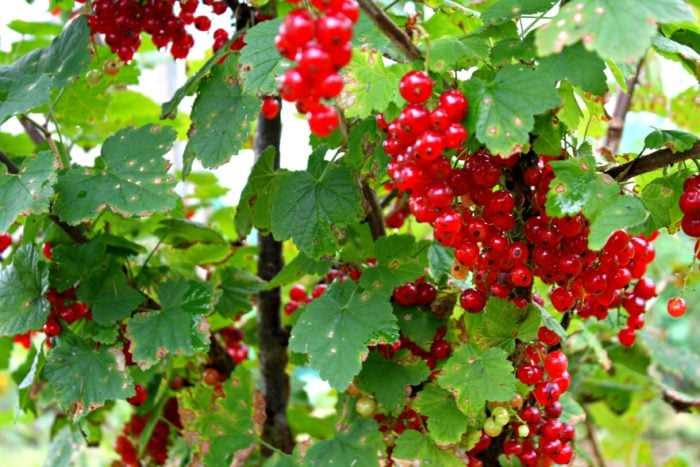
Pruning currant plants is an essential task to ensure their health and productivity. To effectively prune currant plants, you will need the following tools and equipment:
- Pruning shears: These are essential for cutting smaller branches, stems, or twigs. Look for shears with sharp, sturdy blades and comfortable handles.
- Loppers: Loppers are necessary for trimming thicker branches that pruning shears cannot handle. Choose loppers with long handles and sharp cutting blades for easy and precise cuts.
- Pruning saw: A pruning saw is useful for cutting larger branches that are too thick for loppers. Look for a saw with a sharp blade and a comfortable grip for efficient cutting.
- Gloves: Pruning can be a prickly task, so it’s important to protect your hands with a pair of gloves. Opt for gloves that are durable, breathable, and provide a good grip.
- Safety goggles: While pruning, there is a risk of debris getting into your eyes. Wear safety goggles to protect your eyes from potential injuries caused by flying wood chips or branches.
- Pruning paint or wound dressing: After pruning, it’s recommended to apply pruning paint or wound dressing to the cut areas to protect the plant from pests and diseases. Choose a product specifically designed for pruning wounds.
- Disinfectant spray: To prevent the spread of diseases, it’s important to clean and disinfect your pruning tools before and after use. Use a disinfectant spray or wipe to sterilize the tools.
- Bucket or tarp: Pruning will result in a lot of branches and debris. Having a bucket or tarp nearby will make it easier to collect and dispose of the cuttings.
- Sturdy ladder: If your currant plants are tall or have branches that are difficult to reach, a sturdy ladder will be necessary for safe and effective pruning.
Having the right tools and equipment will make pruning your currant plants more efficient and help you achieve the desired results. Make sure to keep your tools clean, sharp, and in good condition to ensure precise and clean cuts.
Step-by-Step Guide to Pruning Currant Plants
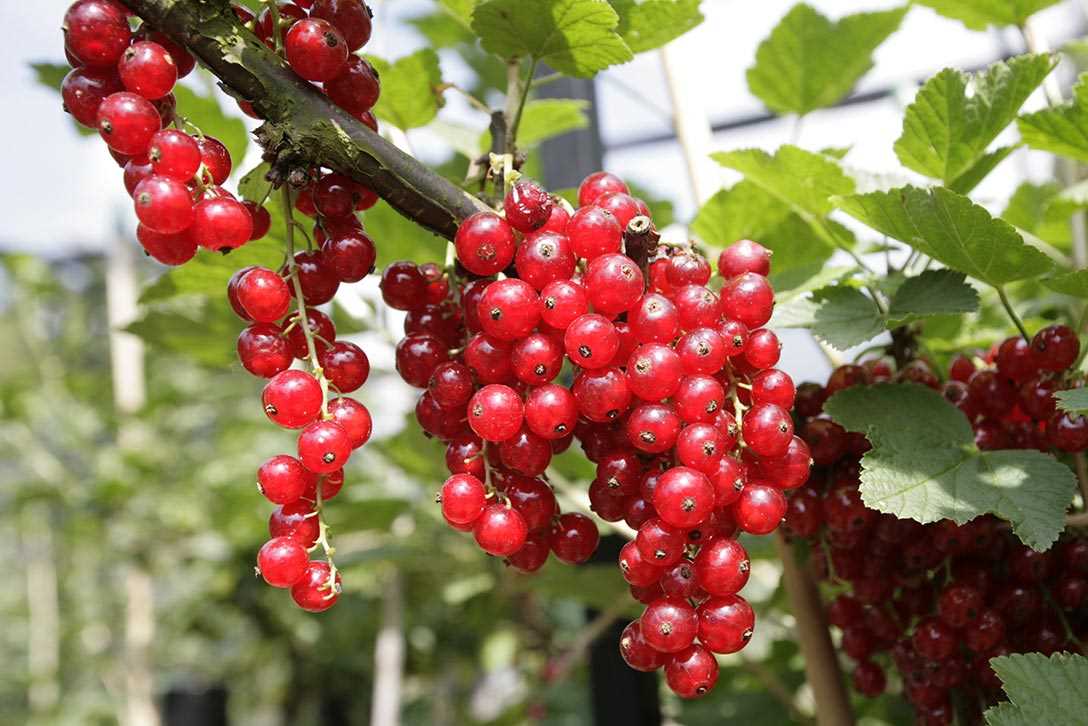
1. Choose the Right Time to Prune
Pruning currant plants is best done in late winter or early spring, before new growth begins. This allows the plant to recover quickly and promotes healthy, vigorous growth.
2. Gather the Necessary Tools
Before you start pruning, make sure you have the right tools on hand. You will need a pair of sharp bypass pruners or pruning shears and a pair of loppers for thicker branches.
3. Remove Dead or Diseased Wood
Start by inspecting the currant plant and identifying any dead or diseased wood. Use your pruning shears or loppers to carefully remove these branches, cutting them back to their point of origin or to a lateral bud.
4. Thin Out the Branches
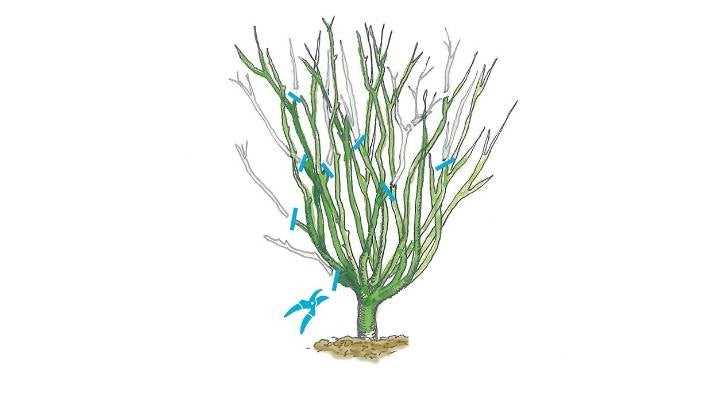
Next, thin out the branches to improve air circulation and light penetration. Remove any branches that are crossing or rubbing against each other. Aim to create an open center, allowing sunlight to reach the inner parts of the plant.
5. Prune for Shape and Size
If your currant plant is overgrown or has an unruly shape, you can use pruning to improve its overall appearance. Cut back any long or leggy branches to promote bushier growth. Trim the plant to the desired size and shape, keeping in mind that it will continue to grow throughout the season.
6. Consider the Type of Currant Plant
Different types of currant plants may require specific pruning techniques. Red and white currants produce fruit on older wood, so it’s important to maintain some of the previous year’s growth. Black currants, on the other hand, fruit on new wood, and can be pruned more aggressively.
7. Clean Up and Dispose of Pruned Material
Once you have finished pruning, collect and dispose of the pruned material. Remove any fallen leaves or debris from around the base of the plant to prevent the spread of disease.
8. Mulch and Fertilize
After pruning, apply a layer of organic mulch around the base of the currant plant to help retain moisture and suppress weed growth. Additionally, you can fertilize the plant with a balanced fertilizer to support healthy growth and fruit production.
9. Monitor Growth and Prune Annually
Throughout the growing season, keep an eye on the currant plant and remove any suckers or unwanted growth. Annually pruning the plant will help maintain its shape, promote fruit production, and ensure overall plant health.
By following these step-by-step pruning guide, you can keep your currant plants healthy, productive, and visually appealing year after year.
Common Mistakes to Avoid When Pruning Currant Plants
Pruning currant plants is an essential task to promote their health and productivity. However, there are some common mistakes that gardeners should avoid when pruning currant plants:
- Pruning at the wrong time: Pruning currant plants at the wrong time of year can lead to reduced fruit production or damage to the plant. It is recommended to prune black and red currants in late winter or early spring before new growth appears, while white currants should be pruned in late summer after fruiting.
- Over-pruning: Over-pruning can weaken the plant and reduce its ability to produce fruit. It is important to avoid removing more than one-third of the total plant each year.
- Pruning too lightly: On the other hand, pruning too lightly can result in overcrowded and tangled branches, reducing air circulation and increasing the risk of disease. Proper pruning involves removing any dead, damaged, or diseased wood, as well as thinning out crowded branches to improve light penetration.
- Pruning too late in the season: Pruning currant plants too late in the season can stimulate new growth that may be vulnerable to frost damage. It is best to complete pruning before new growth begins in the spring.
- Not disinfecting pruning tools: Using dirty or contaminated pruning tools can spread diseases among plants. It is important to disinfect pruning tools with a solution of 1 part bleach to 9 parts water before and after each use.
- Removing too many fruiting spurs: Fruiting spurs are the short, stubby branches that bear fruit. Removing too many of these spurs can reduce the plant’s ability to produce fruit. It is recommended to leave a reasonable number of fruiting spurs intact while pruning.
- Overlooking the center of the plant: It is essential to pay attention to the center of the plant while pruning. Removing any crowded or crossing branches in the center helps to improve airflow and prevent the development of fungal diseases.
- Not shaping the plant: Pruning currant plants is not just about removing unwanted branches, but also shaping the plant to encourage an open, balanced growth. Removing branches that grow inward or cross each other can help maintain a healthy shape and promote better fruit production.
By avoiding these common mistakes and following proper pruning techniques, gardeners can help their currant plants thrive and enjoy a bountiful harvest.
Tips for Maintaining Healthy Currant Plants After Pruning
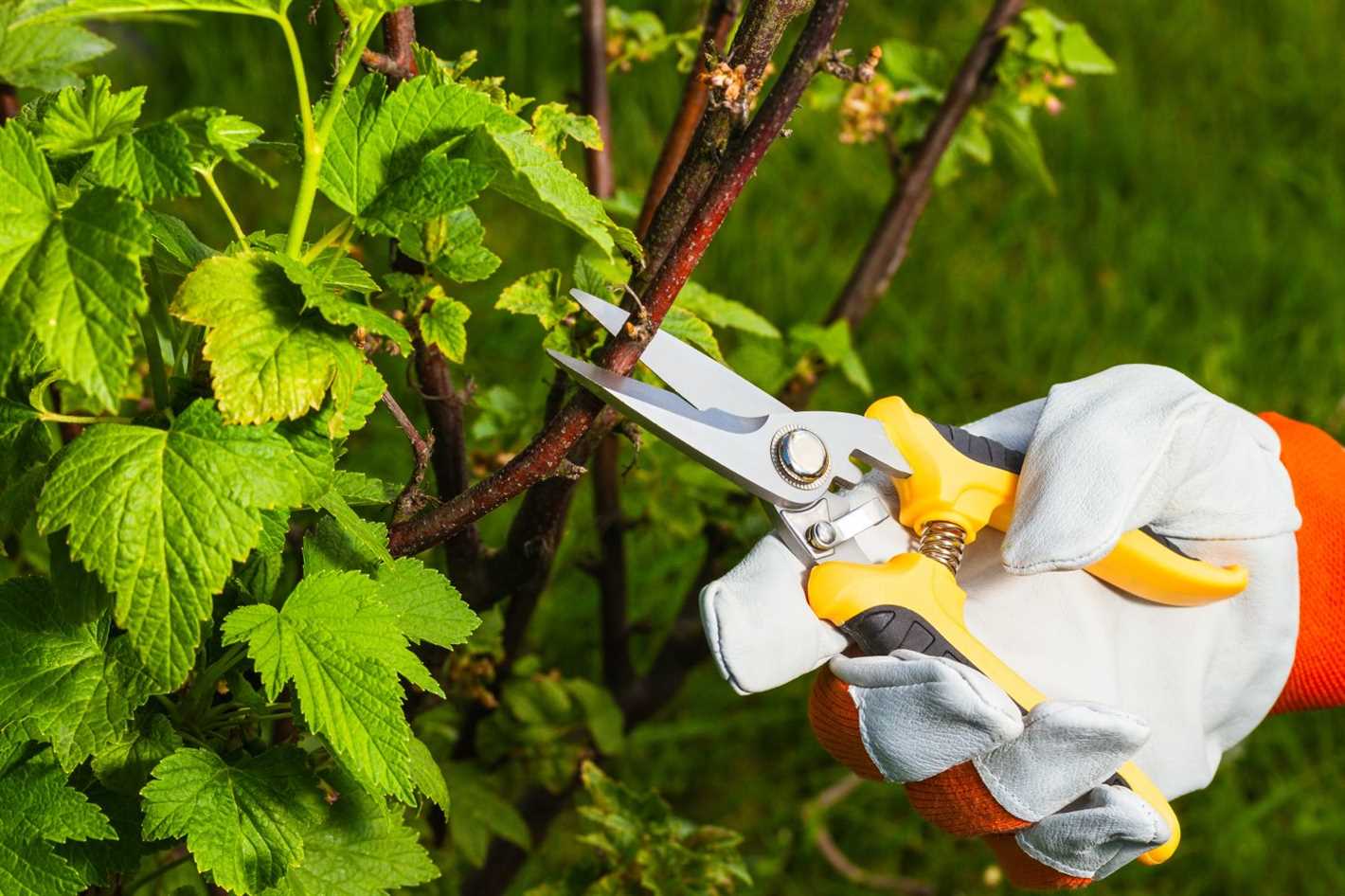
Pruning is an essential part of maintaining the health and productivity of currant plants. After pruning, it is important to take further steps to ensure the ongoing health and vitality of your currant plants. Here are some tips for maintaining healthy currant plants after pruning:
1. Mulch around the base of the plants
After pruning, apply a layer of organic mulch around the base of the currant plants. Mulch helps to retain moisture in the soil, suppress weeds, and regulate soil temperature. It also adds valuable nutrients to the soil as it breaks down over time.
2. Water regularly
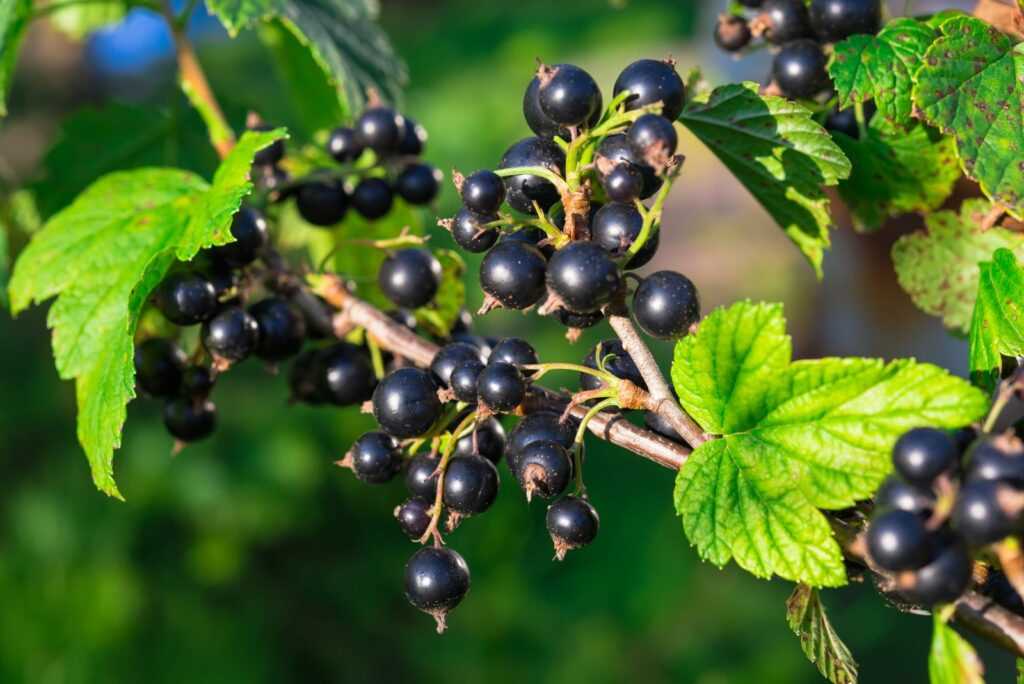
Proper watering is crucial for the health of currant plants. After pruning, water the plants regularly, especially during dry periods. Currants prefer consistently moist soil, so make sure to provide enough water to keep the soil evenly damp.
3. Fertilize appropriately
After pruning, it is a good idea to fertilize the currant plants to replenish any nutrients that may have been lost during the pruning process. Use a balanced fertilizer specifically formulated for fruiting plants and follow the manufacturer’s instructions for application rates.
4. Monitor for pests and diseases
Keep a close eye on your currant plants for any signs of pests or diseases. Pruning can make the plants more susceptible to certain pests and diseases, so it is important to monitor regularly. If you notice any issues, take appropriate action to prevent further damage to your plants.
5. Support the branches
After pruning, the branches of currant plants may be more vulnerable to breakage, especially when they are loaded with fruits. Use stakes or trellises to support the branches and help prevent them from snapping under the weight of the fruit. This will help maintain the overall health and productivity of the plants.
6. Maintain good air circulation
Proper air circulation around the currant plants is essential for preventing fungal diseases. After pruning, make sure that the plants have enough space between them to allow air to flow freely. This will help reduce the risk of diseases and promote healthy growth.
7. Harvest the fruits promptly
Once the fruits are ripe, harvest them promptly. Leaving overripe or rotting fruits on the plants can attract pests and diseases. Remove the fruits carefully to avoid damaging the branches or the remaining fruits.
By following these tips, you can help ensure the ongoing health and productivity of your currant plants after pruning. With proper care, your currants will continue to produce abundant and delicious fruits for years to come.
Question-answer:
When is the best time to prune currants?
The best time to prune currants is in late winter or early spring, while the plants are still dormant.
How much should I prune off my currant plants?
When pruning currant plants, you should aim to remove around one-third of the oldest wood each year.
Should I prune the new growth on my currant plants?
It is generally recommended to leave the new growth on currant plants unpruned, as it will be the fruit-bearing wood for the following year.
Can I prune my currant plants during the summer?
While pruning currant plants during the summer is possible, it is not recommended, as it can stimulate new growth that may not have enough time to harden off before winter.
What are the benefits of pruning currant plants?
Pruning currant plants helps to maintain their shape, improve air circulation, and stimulate new and healthy growth. It also helps to remove dead or damaged wood and promote better fruit production.







